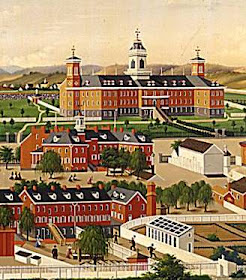Studying American folk art has shown me time and time again how the creative products of an artist can mask the turbulent life from which they had sprung. This is particularly true of a group of painters who were active in Southeastern Pennsylvania in the late nineteenth century. These folk artists were prone to heavy drinking, which resulted in poverty and homelessness. But they had two things going for them; they knew where they could go to get back on their feet, and they could paint breathtakingly beautiful scenery of their favorite havens.
The artists were Charles C. Hoffmann, John Rasmussen, and Louis Mader, and their principal refuge was the Berks County Almshouse in Reading, Pennsylvania. Beginning in the 1870s with Hoffmann, they painted stunning birds-eye views of the Almshouse during their residencies. These large works of art documented the buildings, grounds, and activities of the institution in painstaking detail and bright colors, and were the perfect keepsake for the Almshouse Stewards or Board members who commissioned them.
We are fortunate to have an exceptional Rasmussen in the Fenimore Art Museum collection. The work is painted on tin, dated 1881, and is quite large at roughly 39" x 46". Rasmussen came along a few years later than Hoffmann, and may have seen some of his work in the Almshouse when he was there. He obviously admired Hoffmann's style, as he emulated it in his own works. Here we can see the main campus of the Almshouse strikingly rendered in a large oval at the center, with vignettes of singular structures in each corner and a large decorative patriotic flourish at the top. A tour-de-force of topographical folk painting.
I should note that the main building at the center was where most of the residents stayed; one wing was for the men, the other for women. Other areas of the grounds show a pump house, a schoolhouse, a church, and quite a few fields where a variety of crops are cultivated. All in all, it is a vision of a self-sustaining community. It wasn't all utopian harmony, of course. The building at the lower right (seen in the detail below), with the high enclosure just outside, was for the housing of mentally ill residents who were prone to violence.
The general feeling, however, is one of happiness, plentitude, and safety from the vicissitudes of life. This refuge was only temporary for some, like Hoffmann, who used his skill as an artist to earn his way out. Repeatedly. It was his great misfortune that his alcoholism would not allow him to keep company with money for very long, and he found himself back in the Almshouse in short order. He would then repeat the vicious cycle by painting more of these views to get back out.
We do not know enough about Rasmussen to make the same conclusion, but Hoffmann's experience makes it hard to look at these outwardly joyous paintings without seeing the tragic combination of artistic talent and human frailty that gave them life.





The color on this is amazing. I also like how the oval serves as a portal.
ReplyDeleteIt is painted in brilliant colors, and the oval does make a strong visual statement. Thanks, Joey!
ReplyDeletePaul--
ReplyDeleteSpectacular piece, both artistically and as a view into an bit of that fringe of history that is often overlooked. I may be wrong, but there probably aren't that many such beautiful paintings of poorhouses.
Do you have any idea of how many of Rasmussen's works are known?
I think you are right about the iconography of poorhouses. As far as we know, Rasmussen only did about six views of this facility. At least that's how many survive and are known today.
ReplyDelete